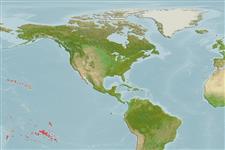>
Tetraodontiformes (Puffers and filefishes) >
Tetraodontidae (Puffers) > Canthigasterinae
Etymology: Canthigaster: Greek, kanthos = the outer or inner corner of the eye, where the lids meet, 1646 + Greek, gaster = stomach (Ref. 45335); criobe: Named for the Centre de Recherche Insulaire et Observatoire de l'Environnement (CRIOBE), Moorea, French Polynesia, in recognition of the laboratory’s continuing support of marine research in the area; noun in apposition..
Environment: milieu / climate zone / depth range / distribution range
Écologie
marin récifal; profondeur 15 - 20 m (Ref. 95278). Tropical
Central Pacific: French Polynesia.
Taille / Poids / Âge
Maturity: Lm ? range ? - ? cm
Max length : 3.9 cm SL mâle / non sexé; (Ref. 95278)
Description synthétique
Morphologie | Morphométrie
Rayons mous dorsaux (Total): 9; Rayons mous anaux: 9; Vertèbres: 17. This species is distinguished by the following characters: D 9; A 9; pectoral rays 17; body depth between origins of dorsal and anal fins, 2.6 in SL; head length (HL) 2.3 in SL; fleshy pigmented skin interorbital width 3.1 in HL; gill opening 8.2 in HL; origin of anal fin posterior to rear base of dorsal fin 3.1 in SL, preanal length 1.2 in SL; longest dorsal ray 2.3 in HL; color when alive, body pale tan with orangish brown stripes; head with uniformly orangish brown snout anteriorly, at middle of snout about 4 narrow, orangish brown stripes radiate posteriorly below eye, 3 stripes extend posteriorly from rear margin of eye, a stripe runs along ridge of erectile tissue on top of head, at deepest part of body there are about 14 narrow orangish brown stripes, middle 5 of those stripes continue to base of caudal fin where they abruptly end (Ref. 95278).
Life cycle and mating behavior
Maturité | Reproduction | Frai | Œufs | Fécondité | Larves
Williams, J.T., E. Delrieu-Trottin and S. Planes, 2012. A new species of Indo-Pacific fish, Canthigaster criobe, with comments on other Canthigaster (Tetradontiformes: Tetradontidae) at the Gambier Archipelago. Zootaxa 3523:80-88. (Ref. 95278)
Statut dans la liste rouge de l'IUCN (Ref. 130435)
Menace pour l'homme
Harmless
Utilisations par l'homme
Plus d'informations
PaysZones FAOÉcosystèmesOccurrencesIntroductionsStocksÉcologieRégime alimentaireÉléments du régime alimentaireConsommation alimentaireRation
Taille/ÂgeCroissanceLongueur-poidsLongueur-longueurFréquences de longueursMorphométrieMorphologieLarvesDynamique des populations larvairesRecrutementAbondanceBRUVS
RéférencesAquacultureProfil d'aquacultureSouchesGénétiqueElectrophoresesHéritabilitéPathologiesTraitementNutrientsMass conversion
CollaborateursImagesStamps, Coins Misc.SonsCiguateraVitesseType de nageSurface branchialeOtolithesCerveauxVision
Outils
Articles particuliers
Télécharger en XML
Sources Internet
Estimates based on models
Preferred temperature (Ref.
123201): 24.5 - 29, mean 27.8 °C (based on 155 cells).
Phylogenetic diversity index (Ref.
82804): PD
50 = 0.5000 [Uniqueness, from 0.5 = low to 2.0 = high].
Bayesian length-weight: a=0.03631 (0.01554 - 0.08482), b=2.88 (2.69 - 3.07), in cm total length, based on LWR estimates for this Genus-body shape (Ref.
93245).
Niveau trophique (Ref.
69278): 3.0 ±0.4 se; based on size and trophs of closest relatives
Résilience (Ref.
120179): Haut, temps minimum de doublement de population inférieur à 15 mois (Preliminary K or Fecundity.).
Fishing Vulnerability (Ref.
59153): Low vulnerability (10 of 100).
